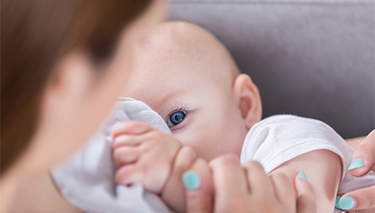Mastitis is an extremely painful infection of the breast that should be treated urgently to prevent an abscess from forming. The initial symptoms of mastitis include swelling, redness, tenderness and pain in the breast. You may be able to treat these symptoms by yourself if this is not an infection of the breast.
Your first course of action is to:
- Continue to breastfeed and start the feed from the breast that has the tenderness.
- Try to position your baby’s chin over the area of redness as this will assist with draining the blocked duct.
- Massage gently, towards the nipple while you are feeding.
- Fully drain your breasts after the feed by expressing to ensure that no milk has been left behind.
If you develop the following symptoms you should seek medical advice as soon as possible. Prompt treatment is essential. These symptoms can develop very quickly and should not be ignored.
- Initially you may feel a hard lump or tenderness in the breast, this is usually accompanied by redness and the breast is hot to touch.
- Fever.
- Tiredness and weakness.
- Muscular aches and pains.
- Flu like symptoms.
- Tearfulness.
The most likely treatment for mastitis
- Antibiotics prescribed by your doctor. If you do take antibiotics be aware of the possibility of thrush developing on your nipples. This displays the symptoms similar to needles piercing your nipple especially during and after breastfeeding. Contact your doctor if this occurs.
- Use of painkillers is recommended. Paracetamol and ibuprofen are suggested treatments.
- Heat your breast by placing a hot wash cloth over it before feeding. Start by feeding your baby from the infected side and try to position their chin over the area that is inflamed.
- After the feed cool your breast down by using an ice pack wrapped in a cloth.
- Ensure you fully drain your breasts.
- Drink plenty of fluids and REST, REST, REST.
Tips for the prevention of mastitis
- Avoid placing pressure on your breast while feeding.
- Ensure your baby has the correct attachment.
- Avoid sudden changes to the length between each feed, especially in the early days of feeding.
- Ensure that the leading breast is drained properly.
For immediate assistance and advice phone your local Australian Breastfeeding Association helpline:
For immediate assistance and advice phone the Australian Breastfeeding Association helpline.
BREASTFEEDING HELPLINE
| 1800-MUM-2-MUM (or 1800-686-2-686) |
For more information see Baby Care
Last Published* May, 2024
*Please note that the published date may not be the same as the date that the content was created and that information above may have changed since.




















